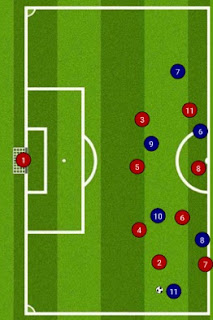Attacking from the Outside

A formation like the 4-4-2 offers plenty of width in the midfield, making the wings an ideal place to begin an attack. However, the ultimate goal is to get the ball to the center where we can score. This post explores a winger's three basic options for getting the ball into the danger zone: The early cross The inside cut The late cross These are ranked in terms of probability of scoring, with the early cross being our best chance, the late cross being our lowest chance, and the inside cut being somewhat in the middle. Let's look at our best chance first: the early cross. Early Cross Our wingers (outside midfielders) will work with either an inside midfielder or a striker to pass the ball around the midfielder and outside defender using a combination of give-and-go passes. Inside-outside passing allows us to get around defenders. Often this requires a sideline run from a striker to overload that position at the defense. In the end, somebody (winger, center mid,...




